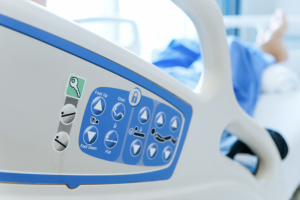Hospital Beds for Home Care
 A hospital bed for home care can provide a patient or loved one with rest and safety. It supports healing and independence in the comfort of home. The right bed can promote quality sleep that contributes to overall good health for individuals recovering from an injury or in-patient stay or adjusting to mobility limitations.
A hospital bed for home care can provide a patient or loved one with rest and safety. It supports healing and independence in the comfort of home. The right bed can promote quality sleep that contributes to overall good health for individuals recovering from an injury or in-patient stay or adjusting to mobility limitations.
Different Types of Hospital Beds
People who use a hospital bed at home often deal with medications, illness, and pain – all of which can affect sleep. A hospital bed for home care provides more support than a standard bed and enables caregivers to deliver quality care. There are several types of hospital bed available to meet the individual needs of patients.
Full-electric hospital beds allow height, head, and feet adjustments to be made with the push of a button. These beds benefit patients who can control the bed positioning. Most full-electric beds also have a feature that locks the bed in a safe position.
- Deluxe hospitals beds are constructed to meet the needs of acute-care patients and caregivers, providing long-term, heavy-duty use. These types of beds can be adjusted electrically and come with user-friendly patient controls. They have side rails, exit alarms, and more features that help make care and treatment easier.
- Residential design beds function like hospital beds but are heavier and styled like furniture. These beds provide comfort, are adjustable electrically, and support the option to install side rails. They help decrease fall risk and promote user independence.
- Specialty hospital beds, or sleep-to-stand beds, are designed to meet specific patient needs and address obese patient weight, fall risks, and more. These adjustable beds provide support for activities like home hospital beds offer such as reading, sleeping, and watching television. They are fully electric, resemble standard beds, prevent falls, and can be adjusted from lying down to standing up for easy transfers.
Semi-electric hospital beds have electric and manual adjustments. The head and foot sections are usually adjusted electrically, and the height is adjusted with a manual crank. The bed’s adjustability promotes user confidence and independence and can benefit someone who has good enough balance without the need to adjust the height of the bed.
- Low beds reduce the risk of injury from a fall for people at higher risk of falling. These beds decrease the distance between the bed and floor and make it easier for users to get in and out of bed. Height and positions on these beds can be adjusted electrically, minimizing the strain on a caregiver during transfers.
- Safety beds come in fixed or with manual or electrically powered heights and are enclosed by fabric, rails, or walls. These beds feature padding to protect users who have seizures and sensory processing disorders. They also have access ports for medical equipment and are available in portable models.
Manual hospital beds do not have as many features and position choices as full-electric and semi-electric bed options. A caregiver must adjust the bed using a hand crank. This type of bed is most appropriate in situations where frequent adjustments are not necessary.
Purchasing a Hospital Bed
Carmichael’s provides an extensive line of home hospital beds and supplies that include fully electric beds, alternating pressure mattresses, patient lifts, transfer boards and trapeze bars. Medicare will cover a home hospital bed as durable medical equipment if it is prescribed by a doctor and medically necessary. Our billing specialists can check your insurance coverage and bill it for you. Contact a Carmichael’s representative to discuss any home medical equipment products and supplies needs or to request additional information.




 Accredited/Certified by The Joint Commission
Accredited/Certified by The Joint Commission